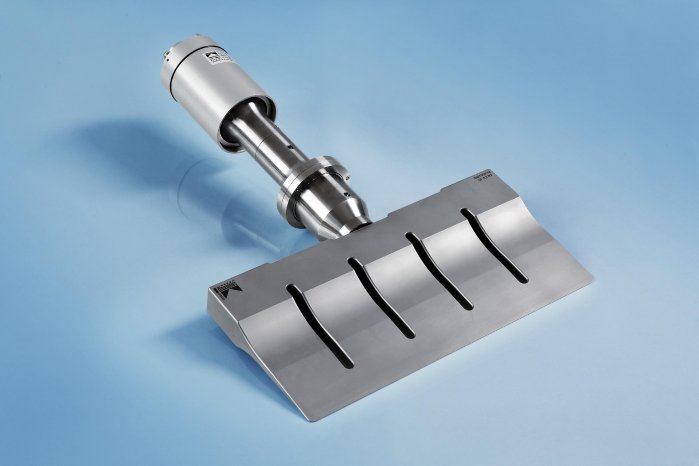Automated cutting is often a great challenge in the case of cakes, gateaux, sweets, rolls, unbaked dough, cold cuts, sandwiches, chocolate, granola bars, and frozen food. When ultrasonics with a frequency between 20 and 40 kHz are used, the known deficits of automated cutting with knives or saw blades, like high material discharge, faulty cutting quality, and high cleaning effort, are almost eliminated.
Cutting cleanly with ultrasonics
In the case of ultrasonic cutting, the cut is not performed with a "sawing motion," but rather using a so-called sonotrode, a cutting tool that oscillates at a high frequency. In the process, very low cutting forces occur, which means that the cutting load is considerably reduced and a better penetration of the material being cut is achieved. Clean, smooth cuts with practically no material discharge are thus guaranteed, even in case of very sticky substances and multilayer products with varying consistencies. At the same time, the oscillations prevent the material being cut from sticking to the cutting tool. This self-cleaning or lotus effect increases productivity since a cleaning-related interruption is still required only in irregular or longer intervals.
Optimally adapted ultrasonic components
The selection of the right components is essential for an efficient ultrasonic cutting solution. For this purpose, Weber Ultrasonics weld & cut (WUW) offers an individual full service in co-operation with partners, from project planning to the accompaniment of production. By working together with well-known cutting system manufacturers for the food industry, the company from Ittersbach-Karlsbad has extensive application knowledge in this area on the one hand, which flows into the product solutions. On the other hand, the entire know-how of the Weber Ultrasonics Group, one of the world's leading manufacturers of ultrasonic components, is available to WUW.
From this combination, product solutions that have been optimally adapted to the applications of the food industry arise. This is demonstrated, for example, in the easy-to-use, low-maintenance ultrasonic generators. Due to their compact construction, they can be easily integrated into standard switch cabinets. The high temperatures that arise especially in bakeries were taken into account with an installed fan.
The converters developed for the cutting systems, which convert the electrical signals generated by the generator into mechanical oscillations, were manufactured from stainless steel in a manner compliant with food safety requirements. In addition, they have IP 68 water protection, which means that the machine can also be cleaned by steam jet without a problem.
Development of innovative cutting tools
To design the geometry of the cutting tool and frequency precisely to the task and to guarantee optimum results, WUW has an accordingly equipped cutting laboratory. The angle and surface of the blade and the surface composition are determined through cutting tests. It is also possible to perform cutting tests on site with mobile devices. This is necessary if the consistency of a material being cut, such as cheese or freshly baked bread, changes in transport.
The company is also working on developments that expand the use of ultrasonic cutting technology in the food industry. This includes, for example, a rotating circular knife that can be used for the continuous cutting of rolls.
The company also deals with food-grade coatings, such as a Teflon coating that enables a manufacturing of aluminium cutting tools. In this way, the costs for the cutting tool can be lowered up to 30 and more per cent in comparison with the titanium material usually used.
Easy automation and retrofitting
The ultrasonic systems permit a problem-free, comprehensive automation of the cutting process – even in case robots are used. Products that cannot be portioned or processed using other methods can often be cut and positioned using ultrasonic technology. An example of this is a frozen gateau (cream cake). This is one of the reasons why WUW not only assumes the conceptual design of ultrasonic systems for new cutting systems, but also the conversion of existing machines to the ultrasonic technology.
More information can be found on the internet: www.wuwc.de.
----
Thank you very much in advance for sending a copy of a document or link to the publication.
Editorial contact partner:
SCHULZ. PRESSE. TEXT., Doris Schulz, Journalist (DJV),
Martin-Luther-Strasse 39, 70825 Korntal, Germany, phone: +49-711-854085
doris.schulz@pressetextschulz.de, www.schulzpressetext.de



